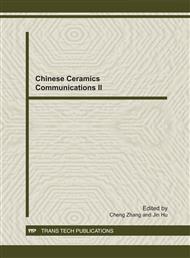p.336
p.340
p.344
p.348
p.352
p.356
p.361
p.365
p.370
Spectral Transmittance of Six All-Ceramic Core Materials after Veneering Ceramic
Abstract:
The spectral transmittance of six kinds of Vita In-Ceram and Cercon all-ceramic core materials after veneering ceramic was determined. Based on the production method recommended by the manufacturer, specimens of the same thickness are made. PERKIN ELMER Spectrophotometer is adopted to measure the spectral transmittance of In-Ceram AL2 slip-casting glass/alumina composite, AL2 electroformed alumina, Z21 slip-casting glass/zirconia composite, Z21 electroformed zirconia, Cercon base color zirconia and Cercon base zirconia all-ceramic core materials, after veneering ceramic. The results show that, after veneering ceramic, Cercon base Zirconia has the highest spectral transmittance, followed by AL2 Electroformed Alumina and Z21 Electroformed Zirconia, whereas the transmittance of Z21 slip-casting Glass/Zirconia composite has the lowest. Statistical data show that, among the groups, In-Ceram slip-casting Glass/Alumina composite (AL2), Electroformed Alumina (AL2), Cercon base color Zirconia and Cercon base Zirconia have significant differences between every group. On the other hand, there is no significant difference between In-Ceram slip-casting Glass/Zirconia composite (Z21) and Electroformed Zirconia (Z21). Therefore, we should choose all-ceramic restoration materials based on the spectral transmittance of all-ceramic core materials after veneering ceramic and transparency of the remaining natural teeth of patients.
Info:
Periodical:
Pages:
352-355
Citation:
Online since:
November 2011
Authors:
Keywords:
Price:
Сopyright:
© 2012 Trans Tech Publications Ltd. All Rights Reserved
Share:
Citation:


